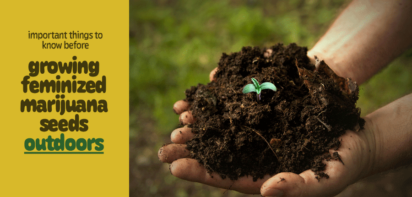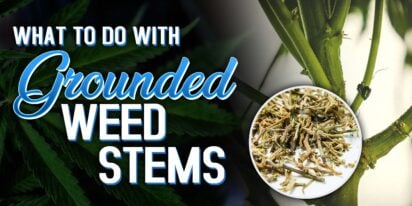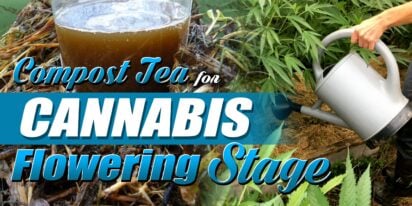
Are You 18 Or Over?
YesOr
No By clicking yes, you certify that you are over 18. By using this website, you agree to our legal disclaimer.605+ Cannabis Strains over 20 Breeders worldwide.
Table of Contents

If you’re considering growing feminized marijuana seeds outdoors, several crucial factors must be considered. Selecting the right feminized cannabis strain, finding the perfect location, and preparing the optimal growing medium. However, having the patience and dedication to see the entire process through is equally vital.
This comprehensive article will discuss everything you need to know about growing feminized marijuana seeds outdoors. Whether you reside in a country where outdoor cultivation is permitted or simply want to explore the possibilities, this guide will provide valuable insights and practical tips.
Marijuana plants can produce either male or female seeds through natural breeding or established cultivation techniques. Regular seeds have an equal chance of producing both male and female plants. This means that growers working with regular seeds have a fifty-fifty probability of obtaining feminized marijuana from each seed.
However, cultivating marijuana from regular seeds can be inefficient. It’s akin to running a bakery that ends up discarding half of its pastry rolls. Growers working with regular seeds must be prepared for the possibility that a significant portion of their marijuana plants may turn out to be male. While male cannabis plants have their uses, excess can hinder the growth of the desired female plants and impact the overall yield.
Pros of Growing Feminized Cannabis Seeds
Prevention of Pollination: By using feminized cannabis seeds, you eliminate the risk of pollination from male plants, ensuring the development of seedless buds with optimal potency.
Simplified Cultivation: With feminized seeds, you don’t need to worry about identifying and removing male plants during the pre-flowering stage. This simplifies the cultivation process, saving you time and effort.
Increased Success Rate: Feminized seeds have nearly perfect success in producing female plants. This means you won’t have to allocate space for plants that will ultimately be removed from the growing area.
Bud Production: All feminized cannabis plants will generate buds, ensuring a bountiful harvest of high-quality flowers.
Cons of Growing Feminized Cannabis Seeds
Reliability of Seed Dealers: It’s important to source feminized seeds from reliable and reputable dealers to avoid the risk of obtaining low-quality or hermaphroditic plants.
Breeding Limitations: If you want to develop new and unique strains, you’ll need male seeds for effective breeding techniques. Feminized seeds may not be the best option in this case.
Seed Production: If you intend to produce seeds, feminized seeds are unsuitable since they inhibit the growth of male plants necessary for pollination.
Growing marijuana outdoors can simplify the cultivation process by eliminating the need for artificial lighting and climate control. The natural environment takes care of these aspects, with sunlight providing essential energy for plant growth, wind aiding air circulation, and rain and soil providing necessary nutrients and protection. While occasional watering and using fertilizer or compost may be required, outdoor cultivation can be cost-effective and efficient.
Location
When planning an outdoor grow, choosing an appropriate location is crucial. Consider the sun’s movement throughout the day and select a spot that receives ample sunlight during both the flowering and vegetative stages. Some potential locations for outdoor cultivation include open fields, forests (with access to water sources), roof terraces, personal gardens (with proper security measures), and balconies (using black plastic sheets for discreetness).
Climate
Climate plays a significant role in the success of outdoor feminized marijuana cultivation. While a sunny climate is often ideal, not all regions offer the same favorable conditions. It’s important to research your area’s climate and consider factors such as temperature, humidity, and seasonal variations to ensure the optimal growth of your plants.
Pest and Mold Prevention
Outdoor cultivation exposes plants to various natural threats, including pests, fungi, stress, and hungry creatures that may be attracted to your cannabis crops. To mitigate these risks, select outdoor feminized marijuana seeds resilient to diseases and molds. Additionally, organic pesticides can help eradicate pests if they affect your feminized plants.

[ez-toc] In indoor gardening, maintaining an optimal temperature within your grow tent is crucial for the health and productivity of your plant

[ez-toc] Welcome to the delightful world of cannafudge crafting, where sweetness meets sophistication, and cannabis infusion adds a unique twis

[ez-toc] You’ve finished trimming your weed, but what about those leftover stems? Don’t throw them away! These seemingly useless bits can a

Feeling high can be an exhilarating experience, but it's essential to make the most of it by engaging in activities that enhance the sensation a

[ez-toc] Starting with planting cannabis seeds might seem simple, but how deep should cannabis seeds be planted for them to grow well. In this

[ez-toc] In the realm of cultivating cannabis, maximizing growth during the flowering stage is a top priority for growers. While various method

[ez-toc] Nutrient burn is a common issue among plant enthusiasts, often resulting from over-fertilization or improper nutrient application. It

[ez-toc] Welcome to our complete guide to dealing with harmful pathogenic mold in cannabis. For those who grow cannabis, preventing mold is vit

In recent years, there has been speculation about “did Shakespeare smoke weed?” This idea originates from a study by South African anthropol

[ez-toc] Welcome to the hidden world beneath the soil – the inside of the marijuana root system. While the vibrant leaves and resinous flower

Are You 18 Or Over?
YesOr
No By clicking yes, you certify that you are over 18. By using this website, you agree to our legal disclaimer.